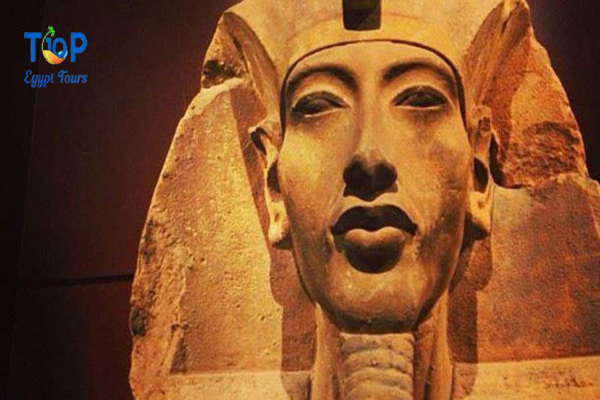King Akhenaten (r. 1353–1336 BC) was one of the pharaohs of the 18th New Dynasty, also known as Akhenaten, the “presented image” of the god Aten.
In this article, we will uncover for you the King Akhenaten with Top Ten Egypt
Akhenaten chose this name because it changed after him to worship the god Aten, and before that, it was called Amenhotep IV (or Amenophis IV). Her parents were King Amenhotep III (1386-1353 BC) and Queen Tia, Queen Nefertiti, and his son Tutankhamun. (From a younger wife called Kia) and Tutankhamun’s wife is Ankhesenamun (daughter of Nefertiti) Kiev.
His rule in the name of Amenhotep continued for five years. He followed the religious policies and traditions of Egypt, but then, in the fifth year, he became famous for his religious transformation.
His reign was known as the Amarna Era because it moved the capital of Egypt from the cultural capital of Thebes to the city he founded, Akhenaten, which became known as Amarna (also Tell el-Amarna). The Amarna Era is considered one of the most exciting eras in Egyptian history and has been studied, discussed, and written about more than any other era. .
Monuments of King Akhenaten
1. Akhetaten (Amarna) – The New Capital:
One of the most significant monuments associated with Akhenaten is the city of Akhetaten, modern-day Amarna. Breaking away from the traditional capitals of Egypt, Akhenaten established this city as the new center of administration and worship. The city was dedicated to the Aten and featured impressive structures, including the Great Temple of the Aten.
2. Great Temple of the Aten:
Located within Akhetaten, the Great Temple of the Aten was the focal point of Akhenaten’s religious reforms. This grand structure was dedicated to the worship of the Aten and served as a center for the pharaoh’s role as the intermediary between the god and the people. The temple complex included open courtyards, sanctuaries, and colossal statues depicting Akhenaten and his family basking in the divine radiance of the Aten.
3. Boundary Stelae:
To mark the boundaries of Akhetaten, Akhenaten erected a series of stelae known as the Boundary Stelae. These inscriptions proclaimed the king’s devotion to the Aten and emphasized his role as the chosen intermediary. The stelae outlined the sacred boundaries of the city and conveyed Akhenaten’s vision for a new religious and political order.
4. Hymn to the Aten:
While not a physical monument, the “Hymn to the Aten” is a literary masterpiece associated with Akhenaten. Composed as a poetic hymn, it praises the Aten and reflects the pharaoh’s monotheistic beliefs. The hymn highlights the sun god’s life-giving attributes and Akhenaten’s unique relationship with the deity, offering insights into the religious ideology of the time.
5. Colossal Statues of Akhenaten:
Throughout Egypt, monumental statues of Akhenaten were erected to emphasize his divine connection to the Aten. These colossal statues depicted the pharaoh with exaggerated features and a prominent belly, symbolizing the life-giving aspect of the sun. Many of these statues were later destroyed or repurposed during the backlash against Akhenaten’s religious reforms.
The death of Akhenaten marked the end of a revolutionary era in ancient Egypt. The circumstances surrounding his death and the events that followed are not entirely clear.The exact cause of Akhenaten’s death remains uncertain.
Akhenaten’s burial also holds intrigue. His mummy has never been definitively identified, and the location of his tomb remains a mystery.
Browse our complete list of Egypt tours Click Here



Comment (0)